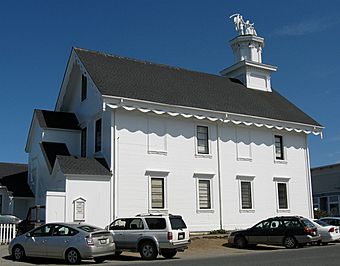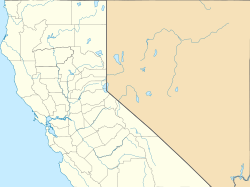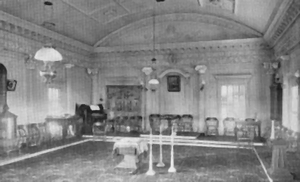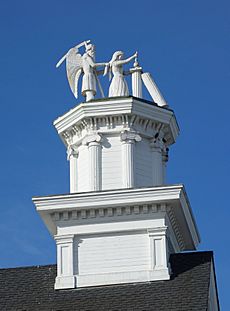Masonic Hall (Mendocino, California) facts for kids
Quick facts for kids |
|
|
Mendocino Masonic Hall
|
|
|
U.S. Historic district
Contributing property |
|

Masonic Hall south face, as seen from Ukiah Street
|
|
| Location | 10500 Lansing Street Mendocino, California, United States |
|---|---|
| Built | 1866 |
| Architect | Erick Albertson and John Gschwend |
| Part of | Mendocino and Headlands Historic District (ID71000165) |
The Masonic Hall in Mendocino, California, is a very old and important building. It's also known as the Masonic Temple or Mendocino Lodge No. 179. This historic building is located at 10500 Lansing Street in the town of Mendocino. It serves as a special meeting place for a group called the Freemasons. They are a worldwide organization that focuses on brotherhood, charity, and moral lessons.
Contents
Building History
The idea for the Masonic Hall started in March 1865. Seven Freemasons who lived in the Mendocino area met in a room above the Mendocino General Store. They realized there wasn't a local Masonic lodge, which they needed to keep their membership active. So, they decided to create a new one.
They followed special rules to ask the main California Masonic group, called the Grand Lodge, for permission. They wanted to name their new lodge 'Mendocino Lodge'. The original notes from this meeting are still kept safe today.
A second meeting happened on July 3, 1865. More people joined, and they chose the first leaders for their new lodge. Erick Jensen Albertson was chosen as the 'Worshipful Master', which is like the president of the lodge.
Their request to form a new lodge was approved on October 23, 1865. The Grand Lodge agreed to the name 'Mendocino Lodge'.
The new lodge first met officially on December 30, 1865. During this meeting, William Heeser offered to donate a piece of land for them to build a permanent hall. This land was at the corner of Lansing and Ukiah streets.
In January 1866, they chose people to manage the building's construction. On February 24, Erick Albertson was chosen to build the hall for $1,000. John Gschwend, a Swiss immigrant known for his building designs, helped Albertson with the plans.
The building wasn't finished until 1873. This was because Albertson also worked full-time at a lumber mill. He also didn't have a dedicated workshop, and the money for the project was paid in small amounts over time.
Time and the Maiden Sculpture
Before the hall was even built, Erick Albertson carved a special sculpture called Time and the Maiden. He carved it by hand from a single redwood tree trunk. The finished sculpture is over ten feet tall. He made it in a small shelter on the beach, using only oil lamps for light.
Even though he made it just for himself, the members of the lodge decided it should be placed on the new building. It was put on top of a small tower called a cupola that was added just for it. This sculpture is also known as Father Time and the Weeping Virgin. It has become a famous landmark in the area.
The sculpture shows an hourglass at the bottom of a broken column. An open book rests on the column. A maiden (young woman) is reading from the book, holding a special pot in one hand and a sprig of acacia in the other. Behind her, an angel with a scythe (a large curved blade) is braiding her hair.
Sculpture Symbolism
Each part of the Time and the Maiden sculpture has a special meaning:
- The hourglass shows how quickly human life passes.
- The urn (pot) and scythe (blade) represent that life will eventually end.
- The broken column symbolizes a life that ended too soon.
- The weeping maiden represents those who mourn or feel sad about a loss.
- The open book she is reading stands for all the good things a person did in their life.
- Acacia wood was used to build the Ark of the Covenant in the Bible. It's also an evergreen tree that resists fire and decay. In the sculpture, it means the human spirit lives on forever.
These symbols are part of a special story or lesson within the Freemasonry group. One Mason explained that the sculpture shows that "time, patience, and hard work can achieve anything."
Landmark Status
The Masonic Hall is an important part of the Mendocino and Headlands Historic District. This district was added to the National Register of Historic Places on July 14, 1971. This means it's recognized as a historically significant place.
Current Use
Mendocino Lodge No. 179, Free & Accepted Masons of California, still holds its meetings on the second floor of the building. In 1977, the building was sold. Now, much of the first floor is used as a local branch of the Savings Bank of Mendocino County.
Images for kids








